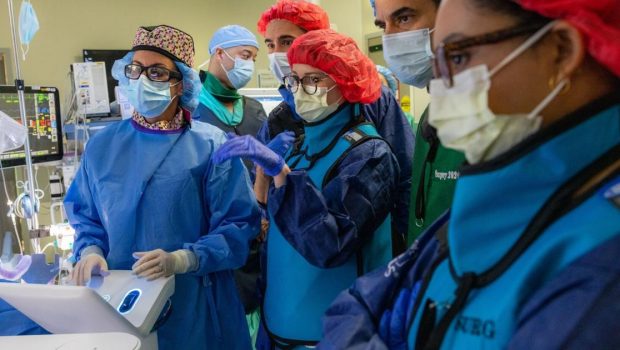Dr. Sara Greenhill is hardly green when it comes to some of the advanced technology in medicine.
When she interviewed for a position at Northwestern Medicine Palos Hospital in July, she had experience with the robotic-assisted bronchoscopy program.
“As I was in the hiring process, this was one of the pieces of equipment or technology that I really thought was vital to be able to grow and advance our program at Palos,” she said.
Well, she got the job as an Interventional Pulmonology specialist and that included bringing the robot technology to the Palos Heights facility to help patients with lung cancer concerns.
According to a news release, when a spot on the lung is detected via imaging, patients want to know as quickly as possible if it is serious and the next steps.
Many patients currently require multiple biopsies before a lung cancer diagnosis, which can add time and anxiety to determining care, the release stated.
People are also reading…
This relatively new robotic-assisted bronchoscopy helps shorten that time by making it possible to reach and biopsy difficult-to-reach nodules in the peripheral lung, where more than 70% of cancer lungs nodules may be located. Previously, these areas of the lung would only be accessible via more invasive methods.
It not only allows the doctor to determine whether the nodule is cancerous but also its stage to accelerate time to treatment.
The tools also allow a doctor to mark the nodule to help surgeons remove as little lung tissue as possible.
Greenhill’s first procedure using the technology at the Palos facility was Oct. 25, and it proved to be a success.
“The first patient had a spot on her lung that was found incidentally,” Greenhill said. “We went through the different options for her, and she opted to wait for this technology to be available at Palos to undergo the biopsy.”
The wait was six weeks, but it usually does not take that long.
“The procedure itself went well,” Greenhill said. “The technology went well. The spot that we were trying to get to was in a fairly difficult location to reach so it took some additional time to get there.
"But we were able to get there, and it’s one of those procedures that without this technology, we would have not even been able to come close to it.”
The Pennsylvania native has been using this type of technology since 2008, and she said she has seen a steady growth in the market.
“It has a larger price tag and I wanted to get more data and experience with their yields before I went to the hospital system to go with,” Greenhill said. “What I’ve been able to see and learn, it’s really increased diagnosis and ease of use and benefit of use.
“It really shows how much the growth in technology has been able to aid and improve care.”
She never dreamed what technology was in store when she was in college and medical school.
“I did not think I would be driving a robot or 'playing a video game for a living' so to speak,” she joked. “It’s definitely a little bit more than that — a lot more than that.”
And it’s something she is glad she can offer area residents.
“It’s honestly been a nice, welcoming experience thus far since being here,” Greenhill said. “The excitement throughout the Northwestern system and getting to grow, advance and spread the lung cancer care in the south region is really exciting to see.”








Gloss